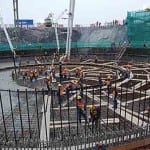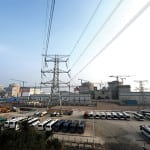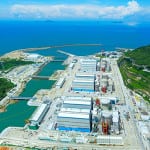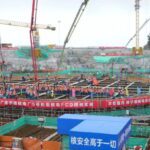Ningde 1, the first of four Chinese-designed CPR-1000 pressurized water reactors being built at a site in Fujian Province, began commercial operation this April after a 58-month construction period. The 1,080-MWe unit was grid-connected in late December 2012 and underwent a 168-hour trial operation before it began commercial operation. The $7.6 billion Ningde reactors, all which will come online by 2015 (Figure 5), are 46% owned by China Guangdong Nuclear Power Co. (CGN) and 44% by China Datang Corp., while the Fujian Provincial Energy Group holds the remaining shares. CGN in February successfully grid-connected Unit 1 of the Hongyanhe Nuclear Power Plant in Liaoning Province, the first nuclear plant ever in Northeast China. That six-reactor project is also slated for completion by 2015.
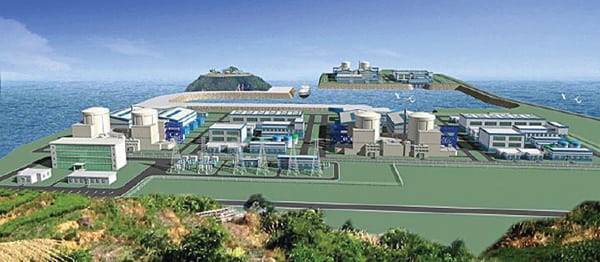 |
| 5. Rendering of Ningde site. The first of four CPR-1000 reactors under construction by the China Guangdong Nuclear Power Co., China Datang Corp., and a local partner at the Ningde site in Fujian Province, China, has begun commercial operation. The second unit is expected to come online later this year, Unit 3 in 2014, and Unit 4 in 2015. Each of the reactors is rated at 1,080 MWe. China will add at least 23 new reactors to its current fleet of 17 by 2015. Most will feature Chinese CPR-1000 technology, but at least four (Sanmen Units 1 and 2 in Zhejiang Province and Haiyang Units 1 and 2 in Shandong Province) will be AP1000s, and two (Taishan Units 1 and 2 in Guangdong Province) will be EPRs. Courtesy: CGN |
China now has 17 reactors in operation, 28 others under construction, and several more in the planning phase. Most are domestically designed reactors that draw from French, Canadian, and Russian technology, though Westinghouse’s AP1000 is expected to be the main basis of China’s transition to Generation-III technology.
China is also developing the Advanced CPR-1000 (ACPR1000) with full Chinese intellectual property rights for export, expected after 2014. This March, CGN Chair He Yu was quoted as saying, however, that China still lacks proprietary nuclear power technology and full intellectual rights that would make it a competitive international player. “Currently, the Chinese nuclear power enterprises generally lack the experience of developing the international market as well as the awareness of marketing, competition, and risk control, and also are in urgent need of talents for internationalization,” he said.
—Sonal Patel is POWER’s senior writer.







